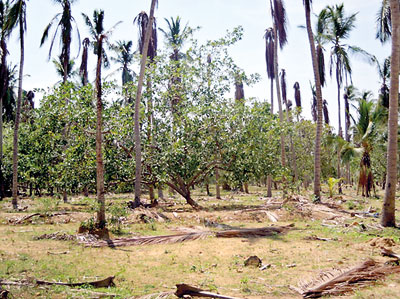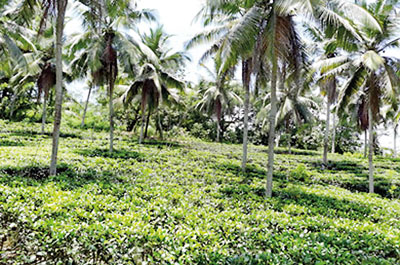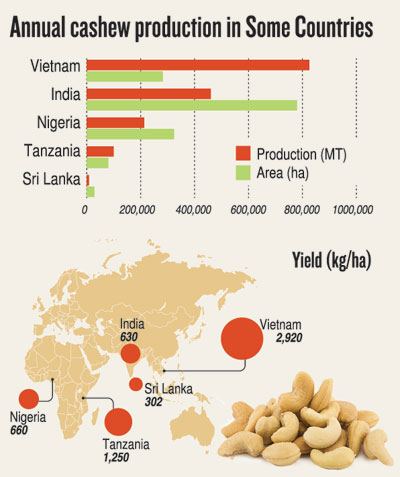Sunday Times 2
Presidential cashew fiasco: How to revive our ailing cashew industry
That the President, on a Sri Lankan Airlines flight, lost his temper on being served poor quality cashew nuts procured from a Dubai supplier is understandable. It was widely reported in the media recently. But, surely, did not the the Sri Lankan Airlines procurement and catering personnel check the quality before it was served, not necessarily to the president of a country, but to anybody! The episode only adds one more to the reported long list of mismanagement record of the airline.

The two-year-old dwarf cashew hybrid yielding 5 kg in the second year
The SLA’s explanation is that the price of the local cashew supplied by the Cashew Corporation (CC) is high and there is uncertainty over its ability to supply the needed quantity. Given the fact that cashew is only served in the first and business classes, and hence the requirement is small, it is hard to believe that the CC or any other local supplier (there are 25 local cashew firms in the country) could not provide assured supplies to the national carrier.
Be that as it may, the local cashew industry’s progress is pathetic. The CC was started some 50 years ago and it has an R&D arm also, but on the whole little has happened over the years.
A research project with the Wayamba University has produced four high yielding hybrids yielding on average 20 kg a tree, but adequate supply of plants is not available to farmers because of the inaction of the CC. Another excuse of the CC is that the army continues to occupy some 100,000 acres in the north and east, and much of this has gone into wilderness.
The Government should intervene to ensure that these lands are returned to the CC or ideally to farmers or commercial growers. It is a fact that our Government has failed in nearly all its agribusiness ventures due essentially to politicisation. As per the statistics published by the Plantation Industries Ministry, the total extent and bearing extent under cashew has increased from 37,000 to 55,000 ha and 28,000 to 41,000 ha respectively in the last decade, but the total production and yield have been stagnant at averages of about 9000 metric tonnes a year and 300 kg per ha per year.
The stagnancy of production is inexplicable despite the bearing extent increasing by 86 percent during this period! Are these statistics accurate (“statistics, lies and damn lies”)? Whatever it is, the table on this page shows the pathetic state of our cashew industry in comparison with that of some key producing countries.
The CC’s R&D arm has apparently done little as evidenced by the statistics. By contrast, the other major cashew growing countries in Africa, South America and Asia have taken vast strides in R&D. The African Cashew Alliance led by Tanzania now has one of the world’s biggest cashew gene banks. It has 38 registered high yielding varieties exceeding 3,000 kg/ha. The yields in Tanzania, like ours, were about 300 kg/ha two decades ago, but R&D progress has been substantial thereafter.
The dwarf hybrid (cultivar AR 4) in the picture is reported to yield 5 kg a tree in the second year after planting and 50 kg by the 15th year! Tanzania’s former President Ali Hassan Mwinyi, on retirement, took to cashew growing and owns a plantation that yields 115 kg a tree at 25 years. Perhaps, our President too should follow suit, take to cashew farming rather than paddy on retirement!
Possibly the world’s biggest cashew gene bank is in Brazil, its north east region being the main cashew growing area. The country has bred 132 early bearing dwarf cashew clones. The genetic variability of cashew there is so great that the writer had the occasion of seeing an exceptional variety, almost a creeper, in Fortaleza, in the Ceara State, 35 years ago! Cashew breeding and related research has also progressed rapidly in India and Vietnam which possess dwarf varieties comparable with those in Tanzania.

Coconut-cashew intercrops in drought-stricken Puttalam
In expanding our R&D in cashew, in the first place it should do well to attach cashew to an existing research institution rather than the CC pursing it. Given the fact that cashew is cultivated largely in the north and east, the Coconut Research Institute appears to be the best bet in terms of proximity to the main cashew growing areas and facilities. It is also already conducting research on coconut-cashew intercropping and has the expertise and other resources to get on with the task. One of the first things that should happen is the introduction of germplasm. Ideally some of the dwarf cultivars from Africa, Brazil, Vietnam or India should be sought.
Droughts in the last several years posed a serious problem to growing cashew as an intercrop in coconut lands in the dry areas of the north and east. A large number of coconut trees perished under intercropping. It would appear that coconut cannot compete with cashew in prolonged droughts, and intercropping cashew in those areas should be stopped. It should be confined to the intermediate zone coconut areas. Or else those areas are essentially utilised for extensive cashew growing given that the profitability cashew at reasonable yields (1000Kg /ha /yr) far exceeds that of coconut.

Tea-coconut intercrop
The loss extent for coconut could be compensated by inter-planting it with tea in the low and mid country wet zones. The potential for this appears substantial, and an economic study (20th Century Tea Research published by the Tea Research Institute) shows that the intercrop yields 29 percent more income than the coconut monocrop. Tea smallholders are already at it, but there is a need for the Tea and Coconut Research Institutes to conduct collaborative research to work out the technologies for expanding wider implementation of the system.
Cashew today is beyond the reach of the ordinary people, being so expensive, but it should be more affordable to our people because of its tremendous health benefits. It has a high content monounsaturated fat (especially oleic and palmitoleic acids) which lowers LDL (bad) cholesterol and raises the HDL (good cholesterol) and hence decreases the risk of cardiovascular diseases. Additionally, it is rich in protein and minerals, especially copper and zinc important for our health. An ounce of cashew nuts contains 160 calories, 5 grams of protein and 13 grams of fat. Also it has anti-oxidant properties which neutralise free radicals believed to be the major cause of several non-communicable diseases.
(The writer is a former chairman Coconut Research Board)


